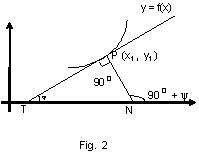Geometrical Meaning of Derivative at Point
The derivative [f'(x) or dy/dx] of the function y = f(x) at the point P(x, y) (when exists) is equal to the slope (or gradient) of the tangent line to the curve y = f(x) at P(x, y).
Slope of tangent to the curve y = f(x) at the point (x, y) is m = tanθ = [dy/dx](x,y)
Equation of Tangent
The equation of tangent to the curve
y = f(x) at the point P(x1, y1) is given by y – y1 = [dy/dx](x,y) (x – x1)
Notes:
(i) If dy/dx = 0 then the tangent to curve y = f(x) at the point (x, y) is parallel to the x-axis.
(ii) If dy/dx –> ∞, dx/dy = 0, then the tangent to the curve y = f(x) at the point (x, y) is parallel to the y-axis.
(iii) If dy/dx = tanθ > 0, then the tangent to the curve y = f(x) at the point (x, y) makes an acute angle with positive x-axis and vice versa.
Equation of Normal
The normal to the curve at the point P(x1, y1) is a line perpendicular to the tangent at the point P(x1, y1) and passing through it. The angle between a tangent and a normal at a point is always 900. The equation of the normal to the curve y=f(x) at a given point P(x1, y1)is given by(x - x1) + (y - y1) [dy/dx](x1,y1) = 0.
Equation of Tangent and Normal If Equation of the Curve is given in Parametric form
If the equation of the curve is in the parametric form x = f(t) and y = g(t), then the equations of the tangent and the normal are
y – g(t) = g'(t)/f'(t)(x–f(t)) and f'(t)[x–f(t)] + g'(t) [y–g(t)] = 0 and respectively
Illustration 9: If at each point of the curve y = x3 – ax2 + x + 1 the tangents is inclined at an acute angle with the positive direction of the x-axis, then find the interval in which a lies.
Key concept: since the tangent is always inclined at an acute angle with the x-axis, hence and the use the concept of quadratic equation that ax2 + bx + c > 0 for all x ÎR if a > 0 and D < 0
Solution: y = x3 – ax2 + x + 1 and the tangent is inclined at an acute angle with the positive direction of x-axis,
=> dx/dy > 0 ∴ 3x2 – 2ax + 1 >0, for all x ∈ R
=> (2a)2 – 4 (3)(1) < 0 => 4(a2 – 3)< 0 => (a – √3) (a + √3) < 0
∴ – √3 < a < √3
Illustration 10: The tangent to the curve y = x – x3 at a point P meets the curve again at Q. Prove that one point of trisection of PQ lies on y-axis. Find the locus of the other point of trisection.
Solution: For y = x – x3, dy/dx = 1 – 3x2
Hence the equation of the tangent at the point P(x1, y1) is;
y – y1= (1 – 3x12)(x – x1)
It meets the curve again at Q (x2, y2)
Hence, (x2– x23)– (x1 – x13) = (1 – 3x12)(x2 – x1)
=> (x2 – x1)[1- (x22 + x1x2 + x12)] = (x2 – x1)(1 – 3x12)
=> 1 – x22– x1x2– x12 = 0
or ![]()
Since x1 ¹ x2, we have x2 = - 2x1
Q is (-2x1, - 2x1 + 8x13)
If L1(α, β) is the point of trisection of PQ then α = 2x1 – 2x1 / 3 = 0. Hence L1lies on the y-axis. If L2(h, k) is the other point of trisection, then h = x1 4x1 /3 = –x1 and k = y1–4x1 + 16x13/3
i.e. k = y1 –4x1 + 16x13/ 3 = –x1 + 5x13
k = h - 5h3
∴ locus of (h, k) is y = x – 5x3.
Angle of Intersections of two Curves
Let C1: y= f(x) and C2: y = g(x) be two curves. If two curves intersect at point P (x1, y1). Then the angle of intersection of two curves is defined as the angles between the tangents at their intersection. And is given by tan θ = f'(x1) – g'(x) / 1 + f'(x1)g'(x1)
Note:
(i) If the curves touch at P, then θ = 0 so that f ’ (x1) = g ‘ (x1)
(ii) If the angle θ = 90o (πc/2, right angle) i.e. Two tangents are perpendicular to each other then the curves are said to cut orthogonally, then f ‘(x1). g ’(x1) =- 1.
Illustration 11: If the curves x2-4y2+c=0 and y2 = 4x intersect orthogonally then find the range of c.
Solution: Curves will intersect if x2 – 16 x + c = 0 has real roots. Thus c £ 64.
For x2 – 4y2 + c = 0, dy/dx = x/4y
For y2 = 4x, dy/dx = 2/y
If curves intersect orthogonally then x/4y.2/y = –1 => x = –2y2 = –8x
=> x = 0 => y = 0. But if y = 0, slope of both curves undefined.
View courses by askIITians


Design classes One-on-One in your own way with Top IITians/Medical Professionals
Click Here Know More

Complete Self Study Package designed by Industry Leading Experts
Click Here Know More

Live 1-1 coding classes to unleash the Creator in your Child
Click Here Know More


